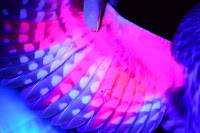Not just anyone can go out and band birds in their backyard. Both state and federal permits are needed to be able to band our native birds. Much training is needed to ensure these birds are not harmed during the banding process and this training goes along with the permitting. Here Steven Kloiber is removing one of the caught Saw Whets out of a mist net, fellow bander Corinne is helping him with light on the other side of the net. These mist nets are specifically made for this purpose and are designed not to hurt the birds in any way when they are caught. There are also specific sizes for specific species.
Once the birds are caught they are then processed. Some, like the individual above being weighed, cooperate and make things easy for the banders. In addition to being weighed the owls are also checked for fat reserves. From what I was shown it is fairly simple to tell weather the owls are nice and plump or are in need of a few meals. Out of seven owls that were captured while I was there, only one looked like it needed to eat a little more.
Measurements of the wings and beak are also taken. All of the data recorded is compiled and is available to researchers in both the US and Canada who are working with this species.
After measurements are taken the Owls then get a band. The bands are issued by the federal government and come in an array of sizes for different species. A special tool is used to determine the proper size for the individual bird. Most Saw Whets get the same size band, but not all. Just like humans, there is variability between individuals and some do need a slightly smaller band. Each band has a unique identification number and a phone number to call if the band is found. This allows researchers to track an individual from place to place when they are recaptured. If you ever find a dead bird check its legs for a band and if you find one, call the number. Even knowing where a bird died can tell something to researchers about the birds life.
The last two checks before release were to get an estimate of the owls age. Under a blacklight new feathers turn pink. On the left is a first year bird. All new feathers glow bright pink. On the right you can see gaps in the pink. The ones not glowing are older feathers. I find it amazing that researchers were able to figure this trick out.
The data collection is a relatively quick process and before being released the owls are held out in the dark for five minutes before being released. This helps them to acclimate back to the dark after dealing with the lights of the banders.
You too can help with taking out the trash! If you get out hiking take a grocery bag with you, give it a second use and fill it with trash while you are out! Every bit helps. You can also help contributing to this project here: Help Fund Taking Out the Trash
Like this project? Like it on Facebook: Taking Out the Trash in Eastern PA










No comments:
Post a Comment